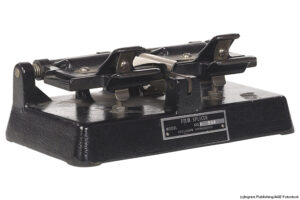
Women were firmly established in the film editing industry for more than a century before Jennifer Lame won the 2024 Academy Award for Film Editing of the movie Oppenheimer. Oppenheimer is 181 minutes long. That is 11 miles long of movie film that weighs 650 pounds. However, digital software has made editing film much easier than when the first women entered the business in the early 1900s. Margaret Booth was one of those pioneering editors who used scissors and tape to put together a motion picture.
Booth’s Film Beginnings

Margaret Booth was born on January 16, 1898, in Los Angeles, California. In June 1915, just days before she graduated from high school, her older brother was killed in a car accident. Elmer had been an actor, working for one of Hollywood’s first film directors, D.W. Griffith. Griffith offered Margaret Booth a job as a film joiner for $10 a week to help her family. Movies were recorded on strips of film at that time. Booth and other female high school graduates with no experience joined together rolls of film into longer sections and wound them onto metal spools, called reels.
Soon Booth was promoted to negative cutter, a difficult and time-consuming editing job. “Cutters” worked with directors and producers to decide which pieces of film should be used, which should be cut, and whether additional scenes needed to be shot. At this time, movies were silent films without recorded dialogue. When cutters watched test screenings, they looked for areas where a film’s pacing needed to be sped up or where a close-up shot might be a better choice.
As a cutter, Booth’s job was to accurately cut and tape or glue together the final version of a film so that it exactly matched what the director wanted. There were no marks or numbers to help her match the original camera frames with what the director had identified on a marked-up sheet. She relied on her vision. She would hand-crank the film from the reel through a box that had a light bulb inside covered by a piece of glass. She could see the negatives as they passed above the light bulb.
Booth used rhythm to help her edit. She ran the film through her fingers and counted as if counting music so that the scene had a satisfying pace. Only then did she make the cut on the negative. The goal was to make the switch from one image to the next as smooth as possible, so that the audience was unaware it was happening.
An Established Presence
In 1921, Booth went to work for Louis B. Mayer and his small studio as a negative cutter. Within three years, the studio had merged with another to become the powerhouse Metro-Goldwyn-Mayer (MGM). Booth was one of only two women of the 24 negative cutters on staff. She became a full editor. Many film editors were women and, until Booth, they were rarely credited for their work.
The Bridge of San Luis Rey, released in 1929, was the first film Booth edited by herself. It included a section of sound, a new development in the late 1920s. Films with sound were known as talkies. Adding sound was a new challenge for film editors because they had to keep the picture and the sound in sync.
In 1935, Booth was nominated for an Academy Award for her work on the film Mutiny on the Bounty, starring Clark Gable. She became the European and U.S. supervising editor for MGM in 1937, overseeing hits such as The Wizard of Oz (1939). She held that position until 1969 when the studio stopped operating. She then worked for Rastar Productions, supervising films such as The Way We Were (1973) and The Goodbye Girl (1977). Her last film was the 1982 production of Annie, directed by John Huston and starring Carol Burnett as Miss Hannigan.
Booth’s Career
During her career, Booth adjusted to changes in the film industry, including sound, color, widescreen, and the age of television. In 1978, the Academy of Motion Picture Arts and Sciences awarded Booth an honorary Academy Award for her contributions to the art of film making. She retired in 1986 after a 71-year career. She died in 2002 at the age of 104. Booth was known in the film industry as the one person directors never questioned when it came to the final cut of a film.
